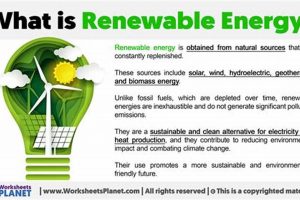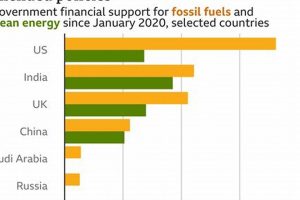
A resource is considered capable of replenishment by natural processes within a human timescale. These resources are naturally replenished, either through reproduction of living organisms or other recurring natural processes. Examples include... Read more »

While often presented as entirely clean, the life cycle of renewable energy technologiesfrom material extraction and manufacturing to operation and disposalcan generate environmental impacts. These impacts can include land use changes, habitat... Read more »

Federal investment in renewable energy technologies encompasses a wide range of activities, including research and development funding, tax incentives, loan programs, and direct grants for projects like solar, wind, hydro, and geothermal... Read more »

Clean energy sources, such as solar, wind, hydro, geothermal, and biomass, offer numerous ecological advantages. They produce electricity without emitting greenhouse gases, the primary drivers of climate change. For example, solar panels... Read more »

Substituting fossil fuels with sources that naturally replenishsuch as solar, wind, hydro, geothermal, and biomassreduces greenhouse gas emissions, the primary driver of climate change. For example, solar panels convert sunlight directly into... Read more »

The combustion of fossil fuelscoal, oil, and natural gasfor energy production is the primary driver of increased greenhouse gas concentrations in the atmosphere. Burning these fuels releases substantial amounts of carbon dioxide... Read more »

Conventional energy sources, primarily fossil fuels (coal, oil, and natural gas), release significant amounts of greenhouse gases, such as carbon dioxide, methane, and nitrous oxide, when burned to generate electricity or power... Read more »

China’s renewable energy generation encompasses diverse sources, including hydropower, wind, solar, biomass, and geothermal. The nation’s capacity and output in these sectors have grown significantly in recent years, transforming its energy landscape... Read more »

A naturally replenishing resource is one that is inexhaustible or can be replaced by natural ecological cycles or sound management practices at a rate comparable to its consumption. Examples include solar energy,... Read more »

Renewable energy sources, such as solar, wind, hydro, geothermal, and biomass, generate power from naturally replenishing resources. While the energy production itself is generally low-carbon, some lifecycle emissions can occur. For example,... Read more »


